Principles of billing
This section describes the rules and principles that are related
to billing. In OSB the billing process has two major components,
maintenance of a balance sheet for each contract and generation of
invoices based on the balance sheets.
|
|
The billing process also could be described this way: In OSB
charges are permanently collected and written to a balance sheet.
Invoice generation groups the charges on the balance sheets,
calculates taxes and determines the GL accounts.
In its current state, the document is an unstructured collection
that reflects the outcome of our discussions.
Billing workflow
This chapter describes the workflow for the generation of one
invoice. For each contract the OSB library creates one invoice. The
billing application is responsible to determine which contracts
should be invoiced and to distribute the workload among the
available billing servers.
Diagram I shows the activities of the billing application:
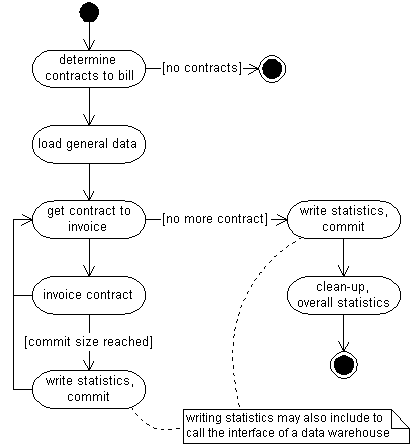
Diagram I: Activity of billing application
|
- At startup the application determines the contract for which an invoice
should be generated.
- The application terminates if there are no contracts to bill,
eventually with an appropriate log message
- During the initialization the application loads all configuration
data, such as products, charges, taxes, ... .
- The application gets the next contract to process.
- If all contracts are processed, statistics are written and the
application terminates after the final clean-up and generating some
overall statistics.
- The application generates the invoice for one contract and gets the
next contract (3).
- After a given number of contracts (commit size) the results are
permanently stored
 |
Statistical data may be written to the interface of a data
warehouse. |
|
This section outlines the multithreaded model for the billing
application that takes care of batch invoicing. viz: preparing of
invoices at the end of the billing period. For example: end of the
month. In batch invoicing the focus is on application efficiency,
where the requirement is to create the maximum number of invoices
in a given time. Our preliminary analysis for a highly adaptive
batch invoicing application indicates that multithreading can be
used as a mechanism to maximise productivity by minimising the
amount of time the CPU will remain idle while the program waits for
resources. The application will use POSIX threads. Most Unix
vendors have adopted the POSIX standards. So programs written uing
the POSIX standard is portable to different Unix platforms.
The application works as follows. The application spawns mainly
two sets of threads: One populator thread and multiple invoicer
threads. The populator thread prepares the data for the contracts
to be invoiced and the invoicer threads works on the data and
prepares the invoice. Each invoicer thread, after completing each
individual invoicing, works on the next contract which is in the
queue, until the commit size is reached when it commits them into
the database. After commit, the thread continues with the
invoicing. Data communication between the populator threads and the
invoicer threads is achieved by maintaining data objects visible to
both the threads.
The application hence uses the producer-consumer model. Another
thread spawned by the application takes care of application
logging.

Activity diagram for the billing application.
The contracts to be invoiced are maintained in a collection
object located at the billing runtime. The populator thread writes
the available contracts to the list from where the invoicer threads
retrieves them for invoicing. The list is maintained at a
predefined maximum size. When the size is reached the populator
thread stops adding contracts to the list, until a condition is
reached where the list is 'almost' empty. This will be a
configurable parameter, which can be set in a configuration file.
When the worklist is almost empty it ensues a signal to the
populator thread. The populator thread which will be in a waiting
condition again starts populating the list.
Similar to the behaviour of the contractor threads, the invoicer
threads too go to a waiting state when it finds the contract list
empty. The threads remains in this state until a signal is issued
by the worklist about an event of another contract added to the
list.

The applications spawns a logger thread that takes care of the
logging process. This is done to increase application efficiency.
Since file operations consumes valuable time, it is advisable not
to give this task to the populator and invoicer threads. The
populator and invoicer threads write the log data to a log-list
object, which is written to the file by the logger thread.

Thread synchronization is achieved using mutexes. When one
thread is about to access the resource, a lock is applied on the
list which is unlocked only after the read/write operation by the
thread is complete. All other threads will have to wait till
then.
The threads communicate with one another mainly for data transfer between them
and ensuing signals between them. Most of these communication can be achieved
by maintaining global variables. The threads writes the status to these variables
while others read. Figure shows the possible tracks of communication between
the threads.

Communication between various threads in the invoicer
application
- From the populator thread to the main thread:
The populator notifies the main thread when its work is complete.
- From the main thread to the invoicer thread:
Main thread communicates to the invoicer thread passing commands for the threads
to stop.
- From the populator thread to the invoicer thread:
The populator notifies the invoicer when a work is added.
- From the invoicer thread to the populator thread:
The invoicer notifies the populator when the list is almost empty.
- From the invoicer thread to the logger thread:
The invoicer thread notifies the logger when a new log message has been added
to the log list.
Inorder to maximise the efficiency of the application, the
generated invoices will not be committed to the database one at a
time. This is to avoid the overhead of performing a database write
for each invoice. The solution is to commit in batches. So a number
of generated invoices are committed into the database en bloc. The
commit size will be a configurable parameter for the user of this
application. Alternatively if there are no more contracts to be
invoiced available in the list, the invoicer thread commits the
invoices already processed.
When the populator has finished adding contracts to the list, it
notifies the main. Main notifies this to the invoicer and logger
threads and ensues a wake-up call for any sleeping threads. The
invoicer threads exits when it finds that there is no more work
left in the list. The logger also behaves in a similar fashion.
Diagram II shows the steps for the invoice generation of one
contract:
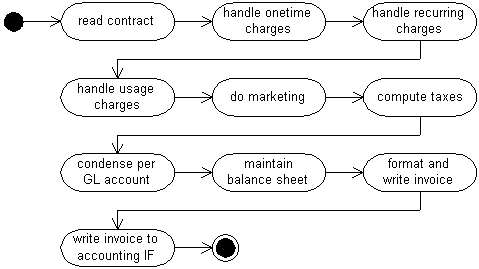
Diagram II: Invoice generation
 |
Per default taxes are computed after marketing. This means that
any amounts generated during marketing are considered for
taxation.
If marketing needs gross amounts, taxes should be computed before
and afterwards.
On the other hand if amounts generated by marketing are never
taxable, there is no need to compute taxes afterwards.
Hint: This is one reason why OSB applications are customer
specific!
|
This chapter discusses the possible ways of storing the
generated invoices (xml files).
Currently, there are mainly two ways to store all the
invoices:
- Placing all the invoices into several directories, and
- Keeping all invoices into a database.
In the first solution, all the newly generated invoices will be
kept in several directories. The purpose of using several
directories is due to the limitation of the directory mechanism in
Unix system. The more file entries in a directory (the directory
size), the slower it is to access it. The directory structure will
be organised as shown in diagram III:

Diagram III: Directory structure from the
"Storing into several directories" approach
Diagram III shows that the system will keep a record of invoices
for 12 months. In the actual practice, this may not be the
case.
 In the
implementation, for the starting of every month, the month
directory must be removed. (e.g. before generating the invoices for
the month March, the system will have to remove the "March
directory" recursively.) After that, a new "March directory" will
be created and the invoices can now be generated. The removal of
old "month directory" is needed because the directory size will
never shrink even if the system has removed all file entries in
it.
In the
implementation, for the starting of every month, the month
directory must be removed. (e.g. before generating the invoices for
the month March, the system will have to remove the "March
directory" recursively.) After that, a new "March directory" will
be created and the invoices can now be generated. The removal of
old "month directory" is needed because the directory size will
never shrink even if the system has removed all file entries in
it.
 Got to determine the total
of invoices that will probably be generated each time in order to estimate the
total subdirectories (under the monthly directories) needed to implement this
approach. Maximum file entries in each directory must also be determined.
Got to determine the total
of invoices that will probably be generated each time in order to estimate the
total subdirectories (under the monthly directories) needed to implement this
approach. Maximum file entries in each directory must also be determined.
Second solution is to store all the invoices into a database (or
at least handle by database). Target DBMS in this solution is the
Oracle8i. This database solution can be further refined into 3
different approaches:
Using object-relational storage
In this first approach, all the invoices (xml files) will be
processed by the DBMS. All the elements (data) will be extracted
from the xml files and inserted into tables. The structure of the
xml file will also be saved into the DBMS. Because all the data has
been put into tables, all actions (e.g. query, update, search etc.)
can be performed on the xml data just as ordinary database data. On
the other hand, because all data has been extracted, all xml files
will be discarded. As a result, the output xml files from the
database may be different from the original copies (the sequence of
the data). Another problem is that all the comments will be
lost.
 Currently, there's
no requirement on updating the invoices (xml files) generated. So, the benefit
of this approach may not be applicable to the system.
Currently, there's
no requirement on updating the invoices (xml files) generated. So, the benefit
of this approach may not be applicable to the system.
Using CLOB data type
In this second approach, each and every invoices (xml files)
will be stored into the database as a CLOB object. In another word,
the whole file will be stored as it is (a sequence of characters).
With this approach, the original files will be kept intact together
with its structures, data sequence, and comments. For this state,
this approach has fulfilled its aim of storing the invoices. If
actions like queries, updates, searches are needed, then the
"InterMedia Text Indexing" feature provided by the Oracle8i can be
used. This indexing method can perform certain parsing action on
the invoices (xml files), gather the needed information, and store
them in the database. Thus, queries regarding xml tags and sections
can be performed.
 If compare, queries
on CLOB data type may not be as fast as the object-relational storage approach.
But again, this is currently not an issue to our system. Furthermore, this approach
do shorten the output time of the invoices (xml files) from the database.
If compare, queries
on CLOB data type may not be as fast as the object-relational storage approach.
But again, this is currently not an issue to our system. Furthermore, this approach
do shorten the output time of the invoices (xml files) from the database.
Using BFILE data type
In this last approach, the DBMS does not actually keep the
invoices (xml files) in the database. All it does is to keep the
invoices in the file system and create locator objects, in the
columns of the tables, to point to the actual files. This approach
can also implement the "InterMedia Text Indexing" to enable
queries, etc. Because the invoices is still intact, all structure,
data sequence and comments are preserved. A great benefit from this
approach is that, the database size won't get too big.
The internal implementation of the Oracle8i DBMS:
- Two kinds of objects need to be created: DIRECTORY object and
BFILE object.
- DIRECTORY object will keep the actual file system path where
all the invoices (xml files) is stored.
- BFILE object will keep two pieces of information. First is the
actual file name, and second is the DIRECTORY object.
- At the time of inserting the record into the table, DBMS will
not validate the availability of the directory path as well as the
file stated.
- It is the system administrator's responsibility to ensure the
directory path and files do exist before any attempts to access
those files by the DBMS.
- System administrator will also need to ensure that the "Oracle
system process" has the READ permission on that directory.
From the understanding of the implementation stated above, the
invoices can be accessed directly without going through the
database.
Invoices need to be kept for future references. No matter which
solution from the above being selected, the storage size issue
still exist. In order to counter this problem, compressing invoices
(xml files) seems to be a possible way. Currently, there exist a C
library named zlib ,
that can be used to perform compression as the invoices are being
generated.
Although this approach do benefit the system from saving up more
then 50% (claimed by the zlib's developers) of storage
space, it make parsing those invoices impossible (without first
umcompress it). In certain cases, for example, the customer care
services, certain specific invoices may be requested by the
customer. In order to get the correct invoices, every invoices will
need to be uncompressed, read, compressed again until the system
found the invoices it needs. In order to counter this problem, the
database solution of Using BFILE data type can be of great
help. Before the invoices have been compressed, they will be parsed
to collect some key information such as date, customer_id, etc.
Those information will be kept in the database along with the
locator which points to the specific compressed invoice (xml
files). This approach, can minimize the number of invoices need to
be uncompressed before the needed invoices to be found.
 Key information to be
extracted will need to be further refine.
Key information to be
extracted will need to be further refine.
Base on the reseach stated above, the best solution will be a
combination of
- Storing into several directories,
- Storing into database (using BFILE object), and
- Using zlib compression.
When the system is generating the invoices, key information will
be captured and stored into database tables. A specially designed
directory structure will be created to keep all the invoices
generated. Before the invoices have been written to a file, they
will be compressed. Finally, each invoice will have a locator
(pointer) pointed from within a database record (row).
This chapter details with the handling of usage records. The
flow is made up of the read records and process records as detailed
below. We might have a sort usage records phase introduced after
reading of records.

Diagram V: The Process of Handle Usage
Charges
The records to be transferred from the database would be
normally in the sorted order of callId and recordId. But there
could be a possibility of a different sort requirement. This has to
be handled in the Application level.
The criteria to get the usage records needs to be specified.
(ContractId for which the records need to be billed).
The process records stage parses all the usage records read. The
charge traits details are identified by referencing the
chargeTraitsId that is available in the usage record. A new
UsageItem is created during this process. A section Id is defined
for the usage record. This section Id is used to display the usage
details in the invoice in a predefined order.
E.g. To List all the international calls, the national calls
followed by the local calls for that particular
contractId.
The above process results in a set of UsageItems and corresponding
UsageDetails to be added to the invoice.
A usage record is the basic information which contains the
following details required to generate an invoice.
- contractId - Id by which the
particular Contract details can be fetched.
- personalizedProductId - Used to
identify the product user.
- productPartId - Identifies the
product and service used (may be composed!)
- callId - Id which ties all the
corresponding records created.
- recordId - Id which identifies the
different records.
- amount - This amount is the raw
amount which is got from the OSB DB.
- chargeTraitsId - This is needed to
identify the tariff details.
Apart from the above the following details can be used for
information purposes which is displayed on the invoice
- startTime
- callDuration
- otherParty
This is Illustrated in the diagram VI.
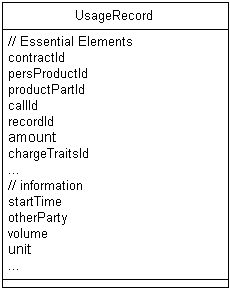
Diagram VI: Elements of the UsageRecord.
A high level view of the UsageRecord is illustrated in the
diagram VII.
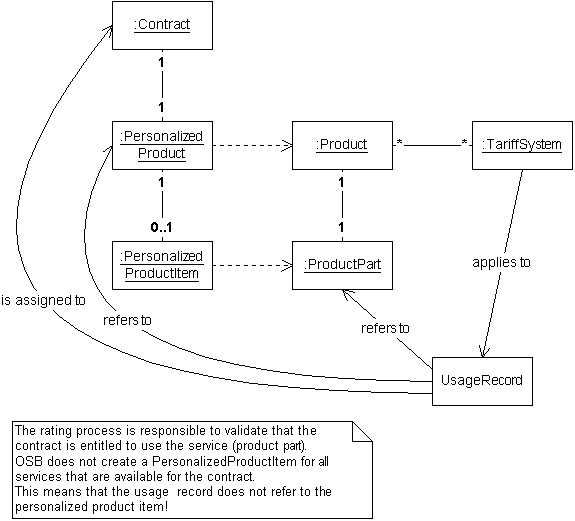
Diagram VII: High level view of the
UsageRecord
A few points need to be noted at this stage
- All data to is be fetched from the OSB Database
- Validation of the contract to use the product item is the
responsibility of the rating process.
- < TariffCharge, TariffPeriod and CallLeg > corresponds to
1 ChargeTrait. Multiple tuples can be incorporated which in turn
corresponds to multiple ChargeTraits.
E.g. A given call can generate more than one Legs potentially.
This is Illustrated in the diagram VIII below.

Diagram VIII: Scenario of different Leg details
being generated.
Balance sheet
OSB creates an invoice for each contract. For each contract OSB
maintains one balance sheet, that stores all charges of the next
invoice. This information allows to define a straightforward
principle for the billing of one contract: The billing application
reads all charges from the balance sheet, calculates the taxes,
determines the GL accounts, forwards the relevant information to
the accounting interface (see below) and converts the invoice data
into the generic format which is stored in the database.
Financial transactions
The billing module writes the generated invoices and their
details to an accounting interface. The accounting system is then
responsible to handle payments and all other financial
transactions.

Diagram III: Billing as client of accounting interface
OSB shows open invoices, received payments and the current
balance of a customer on the invoice. The accounting interface
should provide appropriate functions to retrieve this
information.
 |
The original idea to write all financial transactions to the
balance sheet was dismissed: Transactions handled by an external
finance system should be written to an OSB interface that updates
the balance sheet accordingly. This requirement can not be
fulfilled in all cases. But this would mean that OSB has to support
two different concepts how to retrieve financial data about a
customer and contract. |
Charges
OSB knows three kind of charges: subscription, usage and
one-time charges. Charges can only be risen on the basis of a
personalized product that is assigned to a contract. The definition
of the charges, i.e., how much an item costs and how it is charged,
is linked to the product or its product items.
Subscription charges
Diagram IV shows the status diagram for a personalized product
and personalized product item. For each status OSB allows to charge
subscription fees for the time period a status was valid for a
personalized product and personalized product item.
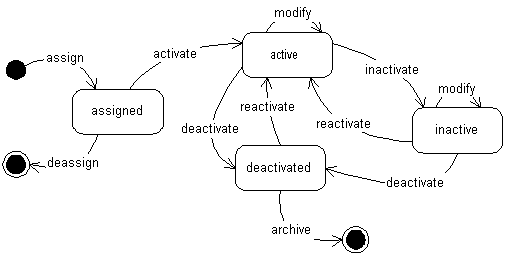
Diagram IV: Status diagram for a personalized
product
One-time charges
One-time charges are billed every time they are assigned to a
contract. Of course there must be a reason for such an assignment:
This can be either a status change, an OSB event or manual
assignment.
(You might think of yet another reason to raise a one-time charge:
The simple fact that a given one-time charge has never been
assigned to a contract before. Technically this is the worst of all
reasons because we have to remember that the charge was billed as
long as the contract exists.)
Events are risen automatically by OSB in well defined
situations. Examples for such events are: Itemized bill calculated,
replacement of a resource, change of address, dunning of an
invoice, ... only to name a few.
Not all events are directly related to one product of a contract:
an invoice, e.g., is generated for all products of a contract.
Because there must be a way to define which charges should be
applied in such situations, the terms and conditions valid for a
contract should include a reference to a product that contains the
necessary information.
Status changes (see diagram xxx) are very similar to events. We
are using a different term because a status changes always refers
to a personalized product or a personalized product item.
Usage charges
Usage charges for a call are calculated during rating by the
RatingRule that is valid for the TariffClass and TariffPeriod of that call.
The billing process is responsible to determine the GL account of
the charge, possibly apply rounding and to calculate any taxes. All
three items are determined from the ChargeTraits that can be configured per TariffClass and TariffPeriod in a TariffSystem. For each call processed by rating this
information shoud be stored in the gnerated usage records to avoid
recomputation of the criteria during billing time.
The next part of this chapter describes the configuration of
charges and later down we'll discuss how the charges that apply for
a personalized product are determined.
Details about the configuration of usage charges are (or will be
:-) described in the class tariffSystem. They are not
discussed any further in this chapter.
Charge configuration
In this subchapter we discuss the configuration of subscription
and one-time charges and how we link event to one-time charges.
There is no difference in the charge configuration of products
and product items with one exception. This is related to the fact
that if a product is assigned to a contract, OSB will always create
a personalized product. For the product items however a
personalized product item is created only if individual
configuration per contract is needed, while other product items are
inherited by the personalized product. We'll discuss the details
further down.
Within this chapter I'll use product to refer to a
product or product item.
Overview
For each Product and
ProductItem charges are configured
separately as shown in diagram V:

Diagram V: Responsibilities of PriceList
The charge configuration is encapsulated in the class PriceList.
This has the advantage that we are free to allow several products
and/or product items to use the same charge configuration, say same
instance, of PriceList. This however
would not only require to maintain a status for a price list but we
also would need functionality to verify that a price list change is
permissible for all products and/or items using this price
list.
Subscription charges
The subscription charges are calculated by subscription
functions, that implement the rules how to calculate a product's
subscription fee. Examples for subscription functions are:
- bill once every calendar month
- bill prorated per day
A subscription function processes the status changes of a
personalized product during the invoiced period and -if applicable-
generates a list of one or more Amount.
Subscription functions can be parametrized, e.g., the time period
which is the basis for proration or which states should be charged
in advance. The number of needed subscription functions is greatly
reduced by the possibility of their configuration
The approach of offering several subscription functions has 2
major advantages:
- Any need specific to an OSB operator can be implemented without
changing any other classes.
- It is much easier to describe and understand in detail what the
function does than one global EierlegendeWollMilchSau
(German term, literal translation egg
producing-wool-milk-porc).
For each status that may be charged we need the charge and the
ChargeTraits: The former is used by the
subscription function to calculate fee for the status and the
latter determine Amount.traits what
allows separate bookkeeping for each product (or product item) and
status.
Additional attributes may be needed to define the charges of each
status. Such attributes however should never be specific to
particular subscription functions: Such a design inevitably would
mix the responiblities. The correct solution is to add such
attributes to parametrization list of the subscription
function.
 |
As of 18-Feb-01 it is not yet decided if we allow
for different currencies for the subscription fees of a product.
Technically there is no problem, but what if we want to charge the
more expensive state if several states apply for a given day and
personalized product? |
You might ask why OSB does not allow to define a
subscription function for each status. We have in fact discussed
this issue quite a long time and finally abandoned the concept:
There must always be a function that coordinates the various
applicable states over the whole invoice period. Such a function
must be either universal or it must be selectable during
configuration. In the first case it is not sure that all
requirements are covered while in the second case configuration
gets more complicated than necessary.
One-time charges
One-time charges are much easier to handle than subscription
fees: Either they are charged or they are not. There is however a
small difference. For some one-time charges, e.g., late fees the
charged amount is a percentage of another amount. This means that
we have to maintain a list of OSB events that are related to
another mount and what exactly this other amount is, for late fees
this would the amount of the dunned invoice.
The only information needed for billing of one-time charges is
the amount and the ChargeTraits.
Eventually we'll need some more settings, mainly to support
configuration and on-line applications, e.g, it should be possible
to flag a one-time charge as being applicable for status changes,
OSB events and/or manual assignment. (Other info to be detected
during design and implementation :-).
Linking to one-time
charges
Status changes and OSB events do not differ in the way they are
linked to one-time charges. For manual assignment no configuration
is needed: the on-line application displays the list with the
one-time charges that are configured for a product (or product
item!) and the user makes his or her selection.
OSB events and status changes may be linked to one or more
one-time charges during the configuration of a product.
Once the product is assigned to a contract and an event is risen,
OSB generates the one-time charges associated with that event and
writes them to balance sheet of the contract. In the second step
billing determines the correct GL account, rounding and taxation
for the one-time charge.
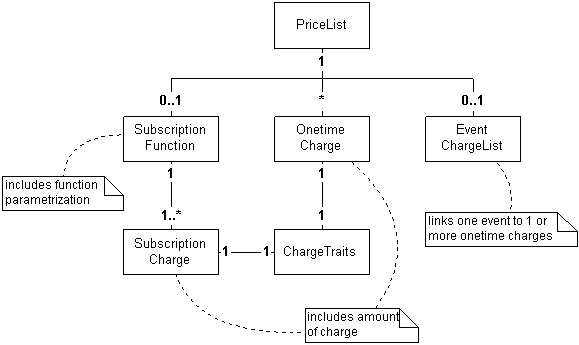
Diagram VI: Elements of a price list
Charge determination
For computation of charges we first need to know if a
personalized product or personalized product item should be
considered at all for billing or not. In the second step we have to
find the status changes that are applicable and to determine for
which time period a status was valid.
Chargeable
products and product items
Diagram VII shows an example of a product P that is assigned to a contract C. P contains 2
product items: cfgPi needs individual
configuration (personalization) for each contract that is not
needed for noCfgPi.
After the product P is assigned to
contract C we will have the following
situation: C contains the
personalized product PP that refers
to P and -because personalization is
needed for cfgPi- contains a
personalized product item. The latter refers to cfgPi and holds the actual configuration for
contract C.
No configuration is needed for the product item noCfgPi, this means that no personalized product
item exists within PP.
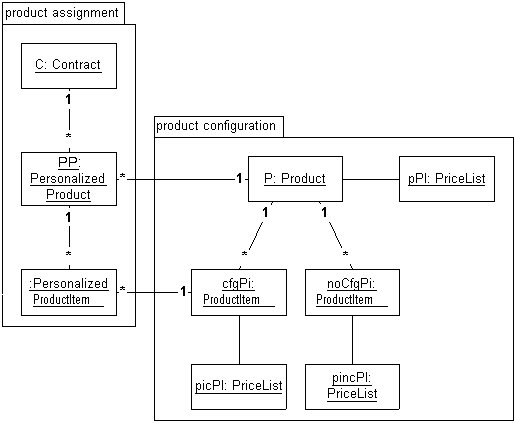
Diagram VII: Sample product assigned to a contract
During billing of contract C we
have to answer the question whether the product item noCfgPi should be charged or not, or -more
precise- if the price list pincPl is
applicable. The problem actually is not only related to billing, it
also applies for customer care, provisioning and rating as well.
Assuming that noCfgPi contains all
GSM call forwarding services the following questions are typical:
"Is call forwarding available for contract C?", " During provision of C, do we have to include the call forwarding
services also?" and "Is it allowable that we receive call
forwarding records for contract C?".
Note that for a product the problem never exists: A product is
either assigned to the contract and charged during billing or it is
not assigned and therefore not available and not chargeable to the
contract.
For a product item the problem is more complicated, diagram VII
does actually not provide enough information about noCfgPi to answer the above questions. Remember
that every product item has an attribute mandatory and may be configurable. With this we can
setup the following decision matrix:
| ProductPart set-up |
PesonalizedProductItem
created? |
ProductPart for contract |
| configuration |
mandatory |
available? |
charged? |
| always |
yes |
always |
always |
always |
| always |
no |
if choosen |
if PPI exists |
if PPI exists |
| never |
yes |
never |
always |
always |
| never |
no |
if choosen |
if PPI exists |
if PPI exists |
| optional |
yes |
if configured |
always |
always |
| optional |
no |
if choosen (configured or not) |
if PPI exists |
if PPI exists |
Table I: Decision matrix for personalized product item (PPI)
In table I the first two columns, configuration and
mandatory, define if a product part needs configuration
and whether it is mandatory or not. For each combination of these
two ProductPart attributes, the third
column defines if OSB needs to create a PersonalizedProductItem, and the last two columns
show if the product part is available and chargeable for the
contract.
From table I we can see immediately that -as it is common sense-
whenever a ProductItem is usable for a
contract, it is charged as well.
This means that we have to provide the rules under which
conditions a product iem is available for a contract. Table I shows
that we can use the mandatory attribute of the product item and the
existence of a personalized product item as criterium.
Until now we have not considered that product items may
themselves consist of other product items. Again it is common sense
that the parts of a product item are available (and chargeable) for
a contract only if the product item itself is usable for the
contract. The decision matrix for the child product items is given
in table II (the result is the same as in table I):
parent ProductPart
available? |
child ProductPart |
PersonalizedProductItem
for child created? |
| configuration |
mandatory |
available |
| yes |
always |
yes |
always |
always |
| yes |
always |
no |
if PPI exists |
if choosen |
| yes |
never |
yes |
always |
never |
| yes |
never |
no |
if PPI exists |
if choosen |
| yes |
optional |
yes |
always |
if configured |
| yes |
optional |
no |
if PPI exists |
if choosen (configured or not) |
Table II: Decision matrix for personalized product item
parts
Using all information from above we are now able to define the
rule when a ProductItem can be used and
therefore is chargeable to the contract. The result is surprisingly
simple:
For a given Contract
C and a Product P assigned to
C (i.e. a PesonalizedProduct for the contract C and product P
exists), a ProductItem PI which is part of P, is available and chargeable to C if and only if
- The parent of the PI is available for the contract AND
- EITHER PI is a
mandatory part of the parent
- OR a PersonalizedProductItem for C and PI
exists
The parent of a ProductItem is either the Product P or a part of
P
|
Subscription periods

by Stephan |
check here for current
status |
Status changes

by Stephan |
check here for current
status |
Subtotals
On an invoice individual charges are usually grouped with
subtotals:
| Usage charges |
| |
Call 1 |
1.07 |
|
| |
... |
... |
|
| |
Call x |
2.45 |
|
| |
Total usage |
27.85 |
|
| |
|
|
|
| Subscription
charges |
| |
Telephony |
12.50 |
|
| |
Internet Access |
5.75 |
|
| |
Total
subscription |
18.25 |
|
| |
|
|
|
| Total net |
46.10 |
| VAT 10% |
4.61 |
| Rounding |
-0.01 |
| Total invoice |
50.70 |
Unfortunately things behind the scene are more complicated as
indicated by the resulting invoice:
- Subtotals that are not visible on the final invoice are needed
as basis for other computations. Consider, e.g., an invoice listing
calls chronologically whereas international calls are taxable at
8%. In this situation an international call belongs to two groups,
namely usage charges and international calls.
- During invoice generation individual charges may change, e.g.,
due to marketing actions or rounding, what -of course- also changes
the related subtotal(s). Without knowing the customer specific
requirements we are not able to predict when subtotals are needed
and when individual charges change. The only general rule is that
amounts must be stable before the invoice is formatted.
The class Subtotal is designed to
overcome the problems described above. Subtotal is a collection of references to
individual item or other subtotals.
Instead of trying to coordinate charge changes and the calculation
of subtotals the sum of the items is calculated whenever
needed.
Rounding
Internally, the OSB billing module works with amounts in a
configurable internal precision. Standard mathematical rounding is
used to determine such amounts.
Each Amount has a rounding rule,
which is used to determine net amount and rounding from the
calculated amount.
Additionally, each Amount also has a
format attribute which defines how the net amount should be
formatted.
For example, assume the precision is 5 digits, rounding rule is
"round to the nearest 5 cents" and the format is "Fr. %.2f":
| original amount |
internal representation |
net amount + rounding |
formatted amount |
| 1/6 |
0.16667 |
0.15 + 0.01667 |
Fr. 0.15 |
 Should we allow for
a rounding rule together with the global precision?
Should we allow for
a rounding rule together with the global precision?
Tax calculation consists of the following two steps:
1) For each invoice item, find the applicable taxes
2) Calculate monetary tax amounts
In the first step we use tax keys to identify a set of
applicable taxes. In the second step, the taxes are calculated and
rounded one by one.
Tax keys are assigned to associates, contracts and product
items. For each invoice item, the combination of these three
taxation keys is evaluated to determine which set of taxes is
applicable. There exists a "catch all" or "wildcard" taxation key
"*" which matches any value in the triplett that is evaluated. The
best match is determined using different priorities for matching
individual taxation keys: a matching associate taxation key has a
higher priority than a matching contract taxation key which has
itself a higher priority than a matching product item taxation key.
The least priority is a "wildcard" match.
Associate taxation keys typically include a "regular" entry for
associates who pay normal taxes and an "exempt" entry for
associates who are exempt from paying taxes. Contract taxation keys
may include "private" and "business" to account for different taxes
for private contracts and business contracts. On the product item,
there may be individual entries for the various applicable taxes
and entries that refer to combinations of taxes, e.g., a "federal
tax", a "state tax" and an "all taxes" entry which would include
both, the federal and state taxes. Without "wildcards", these 2
associate taxation keys, 2 contract taxation keys and 3 product
item taxation keys result in 12 different combinations for the
taxation key triplett:
| associate taxation key |
contract taxation key |
product item taxation key |
| regular |
private |
federal tax |
| regular |
private |
state tax |
| regular |
private |
all taxes |
| regular |
business |
federal tax |
| regular |
business |
state tax |
| regular |
business |
all taxes |
| exempt |
private |
federal tax |
| exempt |
private |
state tax |
| exempt |
private |
all taxes |
| exempt |
business |
federal tax |
| exempt |
business |
state tax |
| exempt |
business |
all taxes |
Each of these tripletts would determine a set of actual taxes to
be applied to the product item in question (e.g., 10% VAT for the
triplett <regular><private><federal tax>).
Assuming that whenever an associate is exempt from tax, then he
does not need to pay any taxes, independent of the contract or
product item, then we can use wildcards for a simpler setup:
| associate taxation key |
contract taxation key |
product item taxation key |
| regular |
private |
federal tax |
| regular |
private |
state tax |
| regular |
private |
all taxes |
| regular |
business |
federal tax |
| regular |
business |
state tax |
| regular |
business |
all taxes |
| exempt |
* |
* |
With this configuration, the tax determined for any taxation key
triplett with an "exempt" associate taxation key is the tax linked
to the <exempt><*><*> entry in the table above,
e.g., a 0% tax.
Assume that even a tax exempt associate still has to pay a flat
state tax, which is always, e.g., 5%. It is enough to add one entry
<exempt><*><state tax> to the configuration and
link it to the appropriate 5% tax. When determining the best match,
we need to consider the priorities set out above. Accordingly a key
triplett <exempt><private><state tax> will match
the new <exempt><*><state tax> rather than
<exempt><*><*> because the matching "state tax"
has a higher priority than the wildcard match for the product item
taxation key.
| associate taxation key |
contract taxation key |
product item taxation key |
| regular |
private |
federal tax |
| regular |
private |
state tax |
| regular |
private |
all taxes |
| regular |
business |
federal tax |
| regular |
business |
state tax |
| regular |
business |
all taxes |
| exempt |
* |
* |
| exempt |
* |
state tax |
 Implementation hint:
taxation keys can be integers (e.g., wildcard=0, regular keys = 1,2,3,...)
Implementation hint:
taxation keys can be integers (e.g., wildcard=0, regular keys = 1,2,3,...)
The result of a search for applicable taxes with a key
triplett should be a list of taxes with at least one item.
Each of these items must then be applied to calculate the tax
amount per tax, round it and assign accounting information to it.
The taxRule contains the logic for this calculation.
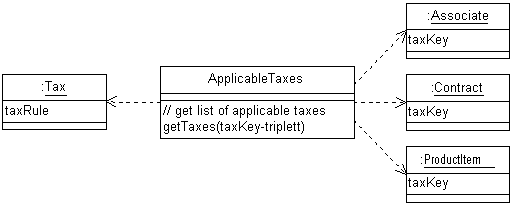
Diagram IV: Taxation classes
This chapter details with definition of classes involved in the
usage records.
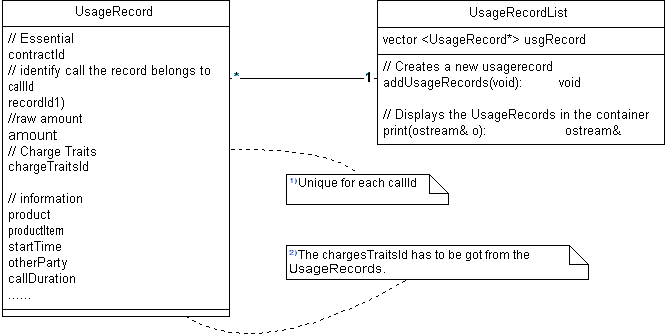
The UsageRecords for a given Contract are read from the
OSB database and the UsageRecordList is populated
Criteria for retrieving the records would be the particular
contract. All calls not billed since last time should be billed.
Assuming that for each call record there would a flag indicating if
the record is yet to be billed on not.
Once the UsageRecordList is created, the List needs to be
sorted. The sort criteria would be on the CallId and RecordId
(could be changed later on).
For every UsageItem, it is mandatory that at
least one UsageDetail should be present.
The relationship is as shown below:
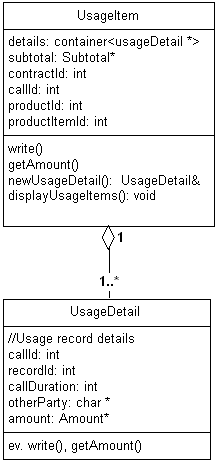
Once the UsageItems and their corresponding UsageDetails are created,
they can be used to generate the Invoice.


















